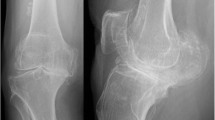Abstract
Background
This study looks at the failure and complications arising secondary to resurfacing and hemi-arthroplasty done at the metatarsal head in patients with hallux rigidus. Our report includes a review of the relevant literature to verify the validity of our techniques.
Materials and methods
We performed metatarsal head resurfacing with hemi-arthroplasty using the HemiCap®, on 12 patients with hallux rigidus between the dates of March 2010 and October 2013. The mean follow-up period was 22.3 months (range 12–54). All patients were clinically and radiologically evaluated according to the American Orthopedics Foot and Ankle Society (AOFAS) functional scale and the Coughlin and Shurnas classification.
Results
The recorded mean AOFAS score showed an increase from the preoperative score of 49.2 ± 13.1 to a postoperative follow-up score of 80.8 ± 13.1 (p < 0.001). Pain scores also showed an improvement from 16.5 ± 7.1 points preoperatively to 32.5 ± 6.9 points during the postoperative follow-up (p < 0.001). The mean function score improved from 17.7 ± 7.6 points preoperatively to 33.2 ± 7.6 points during the final postoperative follow-up (p < 0.001). Furthermore, the mean range of motion improved from 16.3 ± 4.8° preoperatively to 45.4 ± 13.2° postoperatively (p < 0.001). Three patients (25 %) reported pain at rest. Surgical revision was done on these patients who have significant pain that limited their range of motion.
Conclusion
Favorable outcomes were achieved by performing minimal bone resection which also helps maintain metatarso-phalangeal joint function through metatarsal head resurfacing arthroplasty. We expect the failure rates to decrease with the advancements of surgical techniques. Selecting the appropriate patient populous in the application of the technique is crucial in attaining successful clinical results.



Similar content being viewed by others
References
Horton GA, Park YW, Myerson MS (1999) Role of metatarsus primus elevatus in the pathogenesis of hallux rigidus. Foot Ankle Int 20:777–780
McMaster MJ (1978) The pathogenesis of hallux rigidus. J Bone Joint Surg Br 60:82–87
Beauchamp CG, Kirby T, Rudge SR, Worthington BS, Nelson J (1984) Fusion of the first metatarsophalangeal joint in forefoot arthroplasty. Clin Orthop Relat Res 190:249–253
Mann RA, Coughlin MJ, DuVries HL (1979) Hallux rigidus: a review of the literature and a method of treatment. Clin Orthop Relat Res 142:57–63
Carpenter B, Smith J, Motley T, Garrett A (2010) Surgical treatment of hallux rigidus using a metatarsal head resurfacing implant: mid-term follow-up. J Foot Ankle Surg 49:321–325
Kline AJ, Hasselman CT (2013) Metatarsal head resurfacing for advanced hallux rigidus. Foot Ankle Int 34:716–725
Erdil M, Bilsel K, Imren Y, Mutlu S, Guler O, Gurkan V, Elmadag NM, Tuncay I (2012) Metatarsal head resurfacing hemiarthroplasty in the treatment of advanced stage hallux rigidus: outcomes in the short-term. Acta Orthop Traumatol Turc 46:281–285
Meric G, Erduran M, Atik A, Kose O, Ulusal AE, Akseki D (2015) Short-term clinical outcomes after first metatarsal head resurfacing hemiarthroplasty for late stage hallux rigidus. J Foot Ankle Surg 54:173–178
Coughlin MJ, Shurnas PS (2003) Hallux rigidus: demographics, etiology, and radiographic assessment. Foot Ankle Int 24:731–743
Coughlin MJ, Shurnas PS (2003) Hallux rigidus. Grading and long-term results of operative treatment. J Bone Joint Surg Am 85A:2072–2088
Baumhauer JF, Nawoczenski DA, DiGiovanni BF, Wilding GE (2006) Reliability and validity of the American Orthopaedic Foot and Ankle Society Clinical Rating Scale: a pilot study for the hallux and lesser toes. Foot Ankle Int 27:1014–1019
Taranow W, Schoenhaus H, Limaye R, Smith WB, Smith WB, Brigido SA (2015) Advanced hallux rigidus: do we have a choice other than arthrodesis? Foot Ankle Spec 8:119–124
Konkel KF, Menger AG (2006) Mid-term results of titanium hemi-great toe implants. Foot Ankle Int 27:922–929
Papagelopoulos PJ, Kitaoka HB, Ilstrup DM (1994) Survivorship analysis of implant arthroplasty for the first metatarsophalangeal joint. Clin Orthop Relat Res 302:164–172
Swanson AB (1979) Flexible implant arthroplasty of the proximal interphalangeal joint of the fingers. Ann Plast Surg 3:346–354
Sebold EJ, Cracchiolo A 3rd (1996) Use of titanium grommets in silicone implantarthroplasty of the hallux metatarsophalangeal joint. Foot Ankle Int 17:145–151
Erdil M, Elmadag NM, Polat G, Tuncer N, Bilsel K, Ucan V, Erkocak OF, Sen C (2013) Comparison of arthrodesis, resurfacing hemiarthroplasty, and total joint replacement in the treatment of advanced hallux rigidus. J Foot Ankle Surg 52:588–593
Townley CO, Taranow WS (1994) A metallic hemiarthroplasty resurfacing prosthesis for the hallux metatarsophalangeal joint. Foot Ankle Int 15:575–580
Ghalambor N, Cho DR, Goldring SR, Nihal A, Trepman E (2002) Microscopic metallic wear and tissue response in failed titanium hallux metatarsophalangeal implants: two cases. Foot Ankle Int 23:158–162
Giza E, Sullivan M, Ocel D, Lundeen G, Mitchell M, Frizzell L (2010) First metatarsophalangeal hemiarthroplasty for hallux rigidus. Int Orthop 34:1193–1198
Aslan H, Citak M, Bas EG, Duman E, Aydin E, Ates Y (2012) Early results of HemiCAP(R) resurfacing implant. Acta Orthop Traumatol Turc 46:17–21
Gibson JN, Thomson CE (2005) Arthrodesis or total replacement arthroplasty for hallux rigidus: a randomized controlled trial. Foot Ankle Int 26:680–690
Raikin SM, Ahmad J, Pour AE, Abidi N (2007) Comparison of arthrodesis and metallic hemiarthroplasty of the hallux metatarsophalangeal joint. J Bone Joint Surg Am 89:1979–1985
Gheorghiu D, Coles C, Ballester J (2015) Hemiarthroplasty for hallux rigidus: mid-term results. J Foot Ankle Surg 54:591–593
Acknowledgments
Special thanks to Mustafa Sabanli for English grammar revision in this manuscript.
Author information
Authors and Affiliations
Corresponding author
Ethics declarations
Conflict of interest
None.
Rights and permissions
About this article
Cite this article
Circi, E., Tuzuner, T., Sukur, E. et al. Metatarsal head resurfacing arthroplasty in the treatment of hallux rigidus: is it reliable treatment option?. Musculoskelet Surg 100, 139–144 (2016). https://doi.org/10.1007/s12306-016-0410-7
Received:
Accepted:
Published:
Issue Date:
DOI: https://doi.org/10.1007/s12306-016-0410-7




